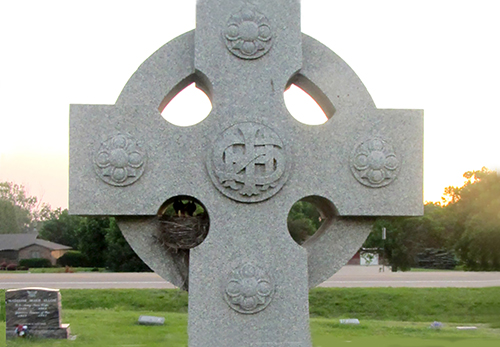O’NEILL, Neb. - The Irish love to share a good story, and in a prairie town settled by Irish immigrants, a few of those tales are sure to be found at a local cemetery. Northeast Community College in O’Neill will feature those stories during an upcoming two-night class in May that includes a visit to a local cemetery.
In Headstones and History, Natalie Butterfield will draw on insider knowledge, based on family ancestry in the Holt County community that dates back to the 1880s, and share stories behind the stones at the historic O’Neill Cemetery.
“The entire cemetery is now designated as the O’Neill Cemetery. In the early days, it was literally divided into two areas: Calvary Cemetery, for Catholics in good standing, and Prospect Hill for everyone else,” Butterfield said. “In the class, I will discuss the reasons for this and why and when the fence surrounding Calvary came down.”
In addition to answering general questions, such as, “What’s with those concrete tree trunk headstones?,” class participants will hear tales of heroism, hilarity and undying love.
“We’ll talk about men who risked their lives in dedication to duty, like William Froelich, the remarkable Kearns brothers, and discuss a blood feud that lasted beyond the grave,” Butterfield said. “We’ll also discuss the saintly Monsignor Michael Cassidy, the Angel of Corregidor, along with rebels, renegades, and ordinary people who endured extraordinary events in the O’Neill area long ago.”
Butterfield’s maiden name was Cook, and her great-great grandfather, Henry, brought his family of young adults from the coalmines of Scranton, Penn., to Gen. O'Neill’s colony in 1877. She said not only was coal mining a dangerous job, there was a threat of violence being associated with the Molly Maguires.
“Ten Irish coalminers were hanged near Scranton in June 1877, so the prairies of Nebraska seemed a much safer place, I'm sure,” she said. “My great-grandparents were the second couple married in the newly-formed Catholic parish. Their original homestead remains in family ownership. The stories handed down from those days, fascinated me even as a kid. My Dad made sure we knew our Irish heritage, Ireland’s ongoing struggles, and the unique history of this area.”
Butterfield works as a registered nurse at Avera St. Anthony’s Hospital. In addition, conducts outreach for the Nebraska Strong Recovery Project through Region IV Behavioral Health in Norfolk.
Another story Butterfield will share involves the founder the world-famous Boy’s Town in Omaha. She said Father Edward Flanigan’s first assignment in O’Neill can be summed up in a quote from his biography, written by Fulton and Will Oursler.
“Brawls, thieving, and gunplay had been a major part of the social activities of the town. By the time Fr. Flanagan arrived, in 1912, ... O’Neill had taken on the quiet respectability of a farming and cattle-raising area.”
“Many eminent figures in Nebraska and national life came from O’Neill,” Butterfield said. “I love to weave all their stories together!”
Butterfield said the class is designed to give anyone interested a deeper knowledge of some fascinating personalities and their circumstances in a way that must be experienced to be understood.
The class (HORC 5130/22S & CRN #70200) will meet two consecutive Thursday evenings, May 19 and 26, from 6:30-8 p.m. The first night will be held at the Northeast Community College Extended Campus, Room 104, 505 E. Highway 20, in O’Neill, for a discussion and presentation, with the second evening concluding with a walking tour of the cemetery. Cost of $30 per person.
To register for the class or for more information, call Northeast Community College in O’Neill, at (402) 336-3590.
--###--
PHOTO CUTLINE
Birds make a nest on the headstone of Neil Brennan in the O’Neill (Neb.) Cemetery. Brennan was an Fenian soldier and the first person to sign up to come to Nebraska as a colonist with Gen. John O'Neill. Natalie Butterfield, who lives in the house Brennan built, will teach a two-night class, Headstones & History, through Northeast Community College in O’Neill in May that focuses on Irish immigration to the region in the late 19th century. The second evening of the class meets in the cemetery. (Courtesy Photo)

